There’s new research from Oregon State University, USA and Peking University, Beijing, China on A Machine Learning Approach to Improve Ranging Accuracy with AoA and RSSI.

Machine learning was used to determine the line-of-sight distance in a multipath (reflective) environment. Due to the multipath effect, acquired signals indoors have complex mathematical models. A machine learning Artificial Neural Networks (ANN) is the most efficient way to process these signals.

The system achieved accuracy where 75% of the errors were less than 0.1 m with a median error of 0.037 m and a mean error of 0.092 m. This reduced ranging errors to under 10cm. The researchers were able to achieve high-precision indoor ranging without the need for a wide signal bandwidth nor synchronisation. The system was also simple and low cost to deploy due to low complexity of the equipment.